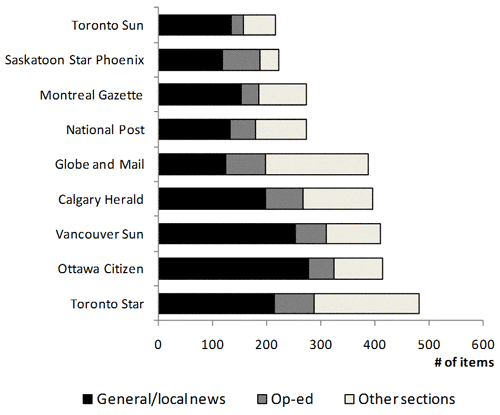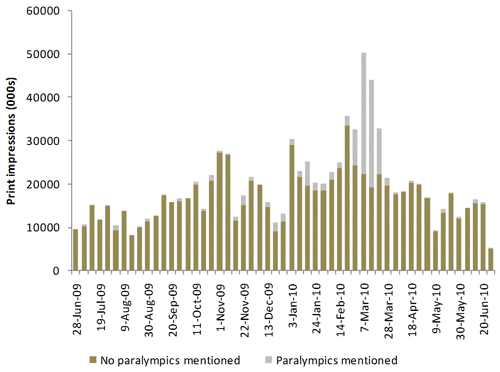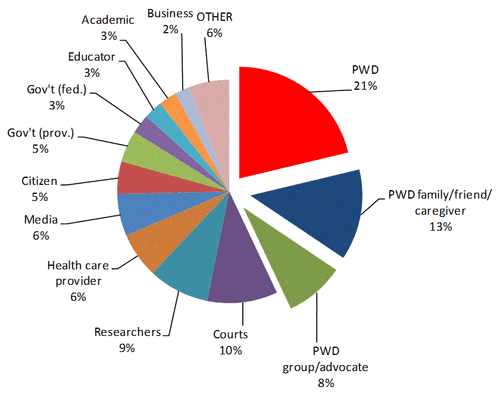Discussion of findings
A. Level of media attention to disability topics in Canada
Newspapers in Canada devoted on average eleven news items per month to disability issues or profiling people with disabilities. The variance between the newspapers in covering disability topics was nominal (see Figure 2). Having said that, the country's largest circulation daily, the Toronto Star, stood out in devoting the most news items – 480 – over the twelve-month sample period. This was possibly reflective of the newspaper's philosophy 4 and of having a regular weekly column on disability. After the Toronto Star were a second tier of newspapers publishing approximately 400 items annually – including the Ottawa Citizen at 413, the Vancouver Sun at 409, the Calgary Herald at 396 and the Globe and Mail at 387. A third-tier published fewer than 300 items annually. This last group included the tabloid Toronto Sun, which published the least at 215 items, along with the Saskatoon Star-Phoenix (222 items) and the National Post and Montreal Gazette (272 items).
- Note #4
- The editorial policy of the newspaper is based on the Atkinson principles set by publisher Joseph E. Atkinson that the newspaper should further social, economic and political reforms and, in particular, tackle issues of injustice.
- Return

Figure2. Volume of news items concerning disability issues by newspaper and location of item in the newspaper between 1 July 2009 and 30 June 2010
| Newspaper | General/ Local | Op/Ed | Other | Total |
|---|---|---|---|---|
| Saskatoon Star Phoenix | 137 | 22 | 57 | 216 |
| Montreal Gazette | 120 | 70 | 33 | 223 |
| National Post | 134 | 46 | 94 | 273 |
| Globe and Mail | 125 | 72 | 191 | 274 |
| Calgary Herald | 198 | 69 | 128 | 387 |
| Vancouver Sun | 254 | 57 | 100 | 395 |
| Ottawa Citizen | 278 | 48 | 89 | 411 |
| Toronto Star | 215 | 74 | 194 | 483 |
- Note #4a
- The numbers in this table have been reconstructed from Figure 2. Use with caution.
- Return
The tenth Paralympic Winter Games held in Vancouver in mid-March 2010 was a notable news event during the sample period that impacted coverage of disability topics in Canada. In total, items referring to the Paralympic Winter Games comprised 12% of the news items sampled and 11% of total estimated audience reach. Not surprisingly, that single event comprised a higher share in the Vancouver Sun (32% of estimated audience reach), while ranging from 4% to 12% in the other newspapers surveyed. Excluding the Paralympic Games, there was no particular story that garnered particular attention or which produced a spike in the estimated audience exposed to a disability topic. The biggest peak in coverage occurred in mid-February 2010 when audience exposure rose to double the weekly average. During this period, attention was significant because of three specific legal cases: the reporting of the case of the Barlagne family, who were denied permission to immigrate to Canada when it was found out that the family had lied about the condition of their teenage daughter who has a disability (Barlagne v. Canada (2010); the ruling against Air Canada by the Canadian Transportation Agency, demanding that the airline provide an environment safe for people with peanut allergies (Canadian Transportation Agency, 2011) and reports on efforts to treat Haitian citizens, specifically those who acquired impairments following the January 2010 earthquake.

Figure 3. Volume of estimated audience exposed to a newspaper item concerning disability issues by week, between 1 July 2009 and 30 June 2010, by whether the item concerned the 2010 Winter Paralympic Games. Survey of nine Canadian newspapers. In thousands of impressions. N=3066.
Stories covering mental health or psycho-social issues comprised 28% of the total sample, a higher coverage than other types of disability. Within stories covering psycho-social issues, , most items made straightforward references to labels such as: depression (32%); and addiction (30%), followed by schizophrenia (16%) and post-traumatic stress disorder (8%). Stories in this category were normally framed using a person with the disability as an example of the wider social implications of the mental health label. In many cases, news coverage of psycho-social issues were found in the context of crime stories in which the perpetrator was labeled as having a psycho-social disability. High-profile criminal cases in a community often result in repeated references to an accused person labeled as having a psycho-social disability.
Mobility impairment was the second most-visible type of disability, and was particularly affected by the coverage devoted to the Paralympic Winter Games in Vancouver. In fact, the Paralympic Games comprised 24% of coverage about mobility disabilities. Excluding this event, mobility topics included 17% of total coverage of disabilities observed. Similarly, vision impairment, while covering 5% of the total sample, also saw a disproportionate level of media exposure because of the Paralympic Games. In all, 41% of coverage of low vision or blindness was found in the context of the Paralympic Games.
Intellectual or developmental disabilities were the next most-reported on category of disabilities, accounting for 14% of the sample of stories. Within this category, autism was the leading specific developmental disability garnering media coverage at 35% of the sub-category, with attention deficit disorders adding 7% and general references to learning disabilities incorporating dyslexia accounting for another 8%.
A notable share of the sample made reference to people with disabilities or 'the disabled' without identifying the type of disability, while several news items referred to multiple categories of disabilities.
Analysis indicated that no particular media outlet paid particular attention to one form of disability more than another if the Paralympic Games coverage is excluded. Having noted that, coverage of issues pertaining to psycho-social disability was somewhat disproportionately higher in the Globe and Mail (38% of total exposure) following that newspaper's particular attention to dementia and depression. As a share of total volume, intellectual disabilities tended to comprise a higher share of coverage in the National Post (18%) and the Montreal Gazette (19%), with the Gazette tending to devote more coverage to the topic of autism than other newspapers surveyed. Overall, however, the breakdown of coverage by type of disability was very similar among the newspapers sampled.

Figure 4. A breakdown by audience exposure of all coverage (excluding Paralympic Games) by major source categories, between 1 July 2009 and 30 June 2010. Survey of nine Canadian newspapers. N=3066.
| Audience | Proportion of Exposure |
|---|---|
| People with disabilities | 21% |
| Family, friends or caregivers of people with disabilities | 13% |
| Advocates and groups of people with disabilities | 8% |
| Courts | 10% |
| Researchers | 9% |
| Health care providers | 6% |
| Media | 6% |
| Citizens | 5% |
| Provincial governments | 5% |
| Federal governments | 3% |
| Educators | 3% |
| Academic | 3% |
| Business | 2% |
| Other | 6% |
B. Voice of people with disabilities in Canadian media Audience Exposure
The level of input by people with disabilities in the media reporting of their issues was included in the analysis. Two variables identified voice
associated with people with disabilities: a) whether a person with a disability, advocate or caregiver was the primary source of information generating the news item; and b) whether a person with a disability, advocate or caregiver was explicitly quoted or paraphrased in the news item.
Figure 3 provides a breakdown by audience exposure of all coverage (excluding the Paralympic Games) by major source categories. The chart indicates that individuals with a disability were the largest source of coverage about people with disabilities issues at 21%, and that people with disabilities, caregivers, supporters and advocates collectively generated 42% of total audience exposure.
In terms of exposure to voice;
in one-in-five stories in the press, the primary source was a person with a disability, and two-in-five Canadians read news item in which a person with a disability or a representative of a disability group or person was viewed as the primary source generating the article. Court rulings concerning people with disabilities made up an additional 10%, with researchers and health care providers combined providing 15%, and provincial and federal government officials adding 8%. The remaining one-quarter of the sample came from a variety of sources, including media opinion leaders, individuals, celebrities, business, educators and academic experts.
The Toronto Star tended to provide a higher share of coverage that included the voices of people with disabilities and their advocates compared to other newspapers.5 People with disabilities were the source of 28% of coverage in the Toronto Star, followed by the Ottawa Citizen with 23% and the remaining papers providing less than 20% of coverage generated by people with disabilities. The Toronto Star also led in terms of coverage generated by other people with disabilities-related sources, including advocates and associations (11%) and caregivers and friends (15%, tied with the Globe and Mail). In all, 53% of coverage in the Star originating from sources related to people with disabilities, compared to 38% in the other newspapers surveyed.
- Note #5
- Keeping in mind that the Toronto Star has a weekly column covering issues of disability.
- Return
A higher proportion of coverage contained explicit statements from people with disabilities and their advocates and caregivers. People with disabilities and their advocates and caregivers were quoted or cited in 64% of total exposure (excluding Paralympic events). Again, that share was observed to be higher in the Toronto Star (70%) than in other newspapers (60% average).
The following section explores the issue of voice and representation of people with disabilities in the media.
C. Coverage of disability rights
A small percentage of the articles in the sample specifically talked about disability within a human rights context. Within that group of stories, the ratification of the UN Convention comprised only 7% of the stories, with the remaining scattered over a range of topics. These included: efforts by Nortel pensioners with disabilities to claim benefits citing the Canadian Charter of Rights and Freedoms (Nortel Networks Corp, 2010); the Robert Latimer case (R. v. Latimer, 2001), coverage of the federal government's disability report (Federal Disability Report 2011); and a number of funding-related stories involving people with disabilities. There was marginal variance among the newspapers (range of 4% to 9%) in the newspapers that specifically highlighted disability rights as an issue.
This study, in examining the media coverage of disability, has divided stories into five cluster areas based on volume of stories on each theme. The first cluster, the right of people with disabilities to have equal access to health care and rehabilitative services, included in CRPD Articles 25 and 26, was portrayed in 22% of all coverage of people with disabilities within the sample. The second cluster was coverage of disability in culture, sport and recreation (Article 30 of the CRPD) 6 . A third cluster included the rights found in Articles 28, 13, 9, 24 and 19 of the CRPD; Accessibility, access to justice, standard of living; independent living; education) was evident, comprising between 6% and 9% of the sample. The fourth cluster of rights comprised Article 10 (right to life) and Article 15 (freedom from torture). The fifth cluster included the remaining articles of the CRPD, which saw relatively little visibility in the media's coverage of people with disabilities, each representing less than 3% of the sample and, as a result, reflected little media attention or audience exposure relating rights. The stories in each cluster were then analyzed to determine the perspective or lens used to frame the story.
- Note #6
- Note: Coverage of the Paralympic Games was excluded from the study.
- Return
